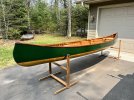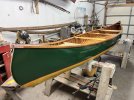I just learned that we can apply shellac on canoes. Until now, I just used it for the handbar of my bike

. I will search of it, but it appears that product is not during in time ? you have to re-apply every year ? Do you apply it after paint ?
I saw two types of shellac (I'm in France, so I have different a access to the products). A no-waxed shellac, and waxed shellac. Which is the good ? The shellac for my bike was in glitters, liquified in alcohol.
You want to use a waxed shellac. Dewaxed shellac will turn cloudy and white upon exposure to water. The merchants of dry, flaked shellac that must be mixed with, and dissolved in alcohol almost always indicated whether a package of flakes is waxy or de-waxed. Preemixed cans of shellac may or may not indicate whether they are waxy or not. But light or white canned shellacs have been de-waxed, and while fine for furniture, should not be used on a canoe. Orange (or amber) shellacs may be either. Though they are usually waxed, there is no way to tell unless the can's label tells you -- and they often don't. The brand that Jerry Stelmok uses (and which I therefore use), Zinsser Amber, gives no indication on the can, but it is apparently waxed.
A shellac bottom coat is applied directly over the filled canvas. Your filler is a bit unusual, by I don't think it will cause any problem if you do decide to shellac the bottom.
A shellac bottom finish is not usually chosen for aesthetics, but for function. Some folks don't much like the way it looks, and sometimes it can be pretty blotchy looking, especially after a time, or if not carefully applied. Though shellac can be applied with a brush, roller, or sprayer, it does not behave like paint when being applied. A couple of thin coats are better than one thicker; work fairly rapidly so you can keep a wet edge. I worked on one side of the bottom at a time, going from one end to the other; the overlap in the center when you do the second side is only slightly noticeable.
Changing the topic for a moment --
You may be interested in four videos made by my wife, Deborah Gardner, a historian who, incidently, has been on the WCHA Board of Directors for a few years now.
The first is
Contemporary Canoe Builders and Their Work
This video won the 2015 Best Documentary award from the Canadian Waterwalker Film Festival. Deborah did all the interviews and put the script for the video together from the interviews. Our friend Ed, a skilled videographer and editor, did the camera work and with Deborah's script and hands-on assistance, edited the raw footage into the final product. Ed had no knowledge of canoes or canoe-building; I helped in advance by taking him to the shops of a couple of builders (Jerry Stelmok, Steve Cayard) I knew, so he could get a sense of what we were undertaking. During the filming, I was basically a factotum, doing the odd jobs needed, and also handling the sound equipment.
We were hired for the second
Allagash River Canoe Trip with Mahoosuc Guide Service
Guides Polly Mahony and Kevin Slater wanted a video of one of their camping trips on the Allagash River to put on their website. We had been recommended to them, and after an introductory meeting, we were hired. Both Deborah and I shot the raw footage for the video while riding in the bows of separate canoes, Deborah with guide Polly Mahony and I usually with Jason Pardilla (assistant guide, a member of the Penobscot Nation, and descendant of Joe Polis, Henry David Thoreau's guide on the tipr the was the basis for Thoreau's
Maine Woods). The video shows how a half-dozen strangers can have a good time together exploring a river none had been on before, with the relative luxury of knowing that a knowlegeable person has put the nuts and bolts of the trip together (transportation, food, equipment, etc.) and had the expert knowleldge to deal with anything untoward happening (none did). On this trip I learned enough about poling a canoe to run a workshop in poling at the next WCHA Assembly. I also wrote an article about the trip that was published in the WCHA Journal
Wooden Canoe.
The third was prepared as an evening presentation for the WCHA's virtual Assembly in 2021, made necessary because the usual live Assembly was cancelled because of Covid
Professional Builders Shop Tour by Jerry Stelmok of Island Falls and Rollin Thurlow
Deborah played a major part in putting the virtual Assembly program together, helping several people who had little or no experience with making any presentation, not to mention a video presentation, create effective videos. Again, for this videao Deborah planned the two presentations and guided us -- the two builders and myself -- going through the two shops as I shot the entire thing with a hand-held camera while walking through the shops. I do not pretend to be a great photographer/videographer -- It's a bit rough and wonky, but not too bad for something done with little preparation and shot on the fly. Deborah can be briefly seen a couple of times in the background during the shooting.
The fourth is an
in memoriam for Tom McKenzie
The Boat Connects the People; An Interview with Tom MacKenzie
Tom was important as one of the early builders active in the revival of interest in wooden canoes, one of three founders of the WCHA, a noted builder, especially of light-weight canoes, and an inovator of free style paddling. Deborah assembled this from some older unused interviews together with a good deal of new interview material. This video was presented at last summer's WCHA Assembly.
. I will search of it, but it appears that product is not during in time ? you have to re-apply every year ? Do you apply it after paint ?




